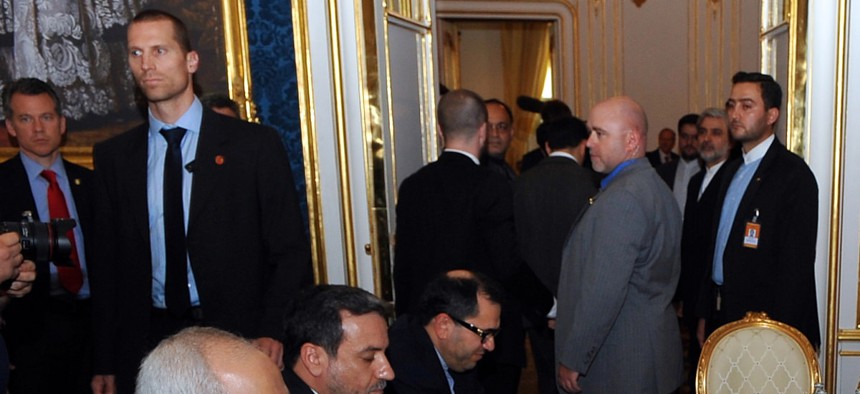
Secretary of State John Kerry meets with Iranian Foreign Minister Javad Zarif on July 13, 2014, for talks about Tehran's nuclear program. State Department
With Talks Extended, U.S. Poised to 'Put a Lid' on Iran's Nuclear Program
Iran’s nuclear program has been boxed in. Now the West has a few more months to put a lid on it. By Joe Cirincione
It is said that the American polity cannot deal with more than two foreign crises at the same time. Unfortunately for those working the Iran issue, the horrific news from Ukraine and Gaza has pushed all other foreign policy issues to the margins.
This last weekend actually brought some good news on Iran. Negotiators from seven nations announced in Vienna that they had agreed to extend talks on limiting Iran’s nuclear program. The talks were up against a July 20 deadline. Diplomats had made substantial progress on many tricky issues but could not close the gap on the key problem of Iran’s uranium enrichment capacity.
The extension is a good thing. It avoids a collapse of the negotiations – and thus avoids the prospect of yet another war in the Middle East or the emergence of another nuclear-weapon state. Talks will now continue until November 24, though many expect a deal could be reached sooner. While talks continue, Iran’s nuclear program remains frozen and will be pushed back in some key areas.
An interim agreement, known as the Joint Plan of Action, or JPOA, remains in effect, halting Iran’s installation of any new centrifuges and any other major activity in its extensive nuclear facilities. Under this plan, Iran has already eliminated the most threatening part of its program: the stockpile of 20 percent enriched uranium gas, according to the International Atomic Energy Agency, or IAEA. This step significantly extended the time it would take Iran to make the core of a bomb, should it decide to do so.
Going forward, Iran agreed to steps making it even more difficult for it to sprint to a bomb, long a worry of Iran critics and nonproliferation experts. Secretary of State John Kerry explained the new commitment in a statement:
In the JPOA, Iran diluted half of its 20 percent enriched uranium hexafluoride and converted the rest to oxide. In this extension, Iran has committed to go one step further and make all of this 20 percent into fuel for the Tehran Research Reactor. Twenty-five kilograms of this material will be converted into fuel by the end of the extension. Once the 20 percent material is in fuel form, it will be very difficult for Iran to use this material for a weapon in a breakout scenario. Attempting to do so would be readily detected by the IAEA and would be an unambiguous sign of an intent to produce a weapon.
In return, the modest sanctions relief will continue and an additional payment of $2.8 billion will be made to Iran in monthly installments. The funds are drawn from the over $100 billion of Iran’s assets frozen in foreign bank accounts. The full sanctions regime remains in place, still crippling Iran’s economy and providing a strong incentive for its leaders to reach a comprehensive agreement.
While it would have been better to finalize a deal this month, the extension may have been inevitable. As my colleague, George Perkovich of the Carnegie Endowment for International Peace, predicted, it was just impossible for either the U.S. or Iran to reach a deal without testing the limits. He said last May:
The Iranians can't agree to something before a deadline. By definition, if you agree to something before a deadline, you did not negotiate hard enough. You have to go beyond a deadline, to a point where there is a crisis, and then pull back and tell your critics at home that you got the most you could.
After an extended break in August (something the Europeans reportedly insisted upon), negotiators will return, perhaps in a better position to actually come to a deal. The key will be finding a creative way for the Iranians to back down without losing face.
Iranian diplomats currently insist they need to keep every one of the 19,000 centrifuges they have (with about 10,000 operating) and to add tens of thousands more. This is a very long way from the original Iranian view that they merely needed the United States to recognize its “right to enrich.” Former U.S. negotiator Robert Einhorn says, “The evolution of Iranian positions on enrichment might be called ‘rights creep.’”
None of the six nations negotiating with Iran (U.S., UK, France, China, Russia and Germany) can accept a uranium enrichment capacity this large. As Einhorn points out, the Iranian demand “fails the realism test.” It is many times larger than what Iran could conceivably need to make fuel for its research reactors, and it would allow Iran to quickly enrich uranium for weapons should it decide to do so.
So, how to back them down? Experts will be working intensively over the next few months to provide new approaches. The solution is likely along the lines suggested by Arms Control Association Executive Director Daryl Kimball.
“Negotiators can square the circle with a combination of additional measures,” he argues, including sharply limiting Iran’s enrichment capacity for 6 to 10 years and limiting the amount of stored uranium gas that could be pumped into centrifuges, but allow Iran to research more modern centrifuges and assist it with technology for actually making fuel rods for its power reactors—something it cannot currently do.
This might be the kind of face-saving solution that allows Iran to limit its program yet still leave the table declaring victory. In the end, negotiations only succeed when they forge a workable compromise that allows all sides to claim success.
Until that compromise is crafted, Iran’s program remains more constrained than any time in the past decade. Sharply limited and rigorously inspected, it has been put in a box with a camera on it.
After an August break, negotiators will return to see if they can put a lid on it.
Joe Cirincione is president of Ploughshares Fund and the author of Nuclear Nightmares: Securing the World Before It Is Too Late.





